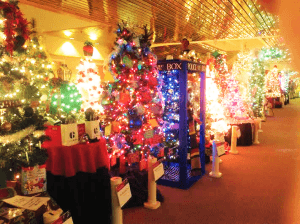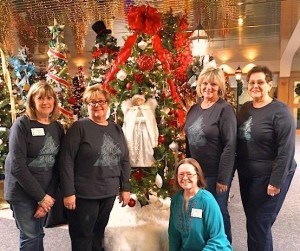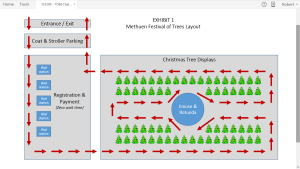Methuen Festival of Trees Creates Value through Two-Sided Marketplace

The Methuen Festival of Trees brings local businesses together with members of the community every Christmas to raise hundreds of thousands of dollars for historical restoration projections.
Great operating models sometimes come giftwrapped in small packages. Such is the case with the Methuen Festival of Trees, the largest holiday event in the Merrimack Valley. Now in its twenty-second year, the Festival raises money to preserve and restore local historical sites. This year’s Festival featured over 240 Christmas trees, and welcomed over 27,000 visitors. In just two weeks, the event likely raised between $200,000 and $300,000 in gross revenue, with very limited overhead.
Fundamentally, the Festival of Trees is a Christmas fundraiser; however, it is also a two-sided marketplace, as it brings together both (A) local businesses, as well as (B) individual members of the community. The Festival creates value for both groups. Local businesses volunteer to decorate and donate individual Christmas trees. The trees are thematically decorated to reflect the business activities of the donor (e.g. a dentist office submitted a tree decorated with supersized teeth, toothbrushes, and – at the top of the tree – a Tooth Fairy). The Festival gives businesses the opportunity to advertise to thousands of local patrons, as well as generate goodwill within the local community. The Festival also creates value for visitors by providing them with a friendly and affordable venue in which to socialize and celebrate the holiday season. For many families, attending the Methuen Festival of Trees is a longstanding tradition offering religious, communitarian, and nostalgic significance. The venue also provides patrons the pleasant experience of get lost in a forest of spectacularly-decorated trees.

The Festival generates revenue by charging patrons an admission fee. Patrons may also purchase holiday treats, photos with Santa, and raffle tickets. The business model hinges on building both sides of the two-sided market, all while minimizing operating costs. The Festival’s operating model (i.e. the way it translates its assets into business activity) is very well-aligned with these goals.
Organizers first must entice local businesses to participate – which requires a combination of appealing to business owners’ altruism, as well as convincing the business owners that attendance will be strong (even before any tickets have been sold). Organizers have several assets at their disposal to do this. They have an outstanding reputation and history in the community, impressive historical attendance figures (“It gets bigger and better every year”), and information on the historical projects they have funded (over 140 projects to-date). They promote these assets to businesses via advertising designed to create buzz (Facebook page, articles in local periodicals, signage), as well as an e-commerce website on which businesses can sign-up to donate trees. Organizers use lists of local businesses and relationships within the community (including prior years’ participants) to identify potential Christmas tree donors. The Festival primarily uses volunteer labor to manage its advertising and participant outreach.

Next, the organizers must deliver the promised patrons to the event. In addition to the advertising resources mentioned above, the Festival uses its other assets creatively to deliver value to patrons. First, they use the Christmas trees themselves to drive a level of engagement above-and-beyond merely “tree-gazing”. Young participants are given a “scavenger hunt” list when they first enter the showroom; the list includes several unique items that are scattered throughout the tree decorations (e.g. “The Tooth Fairy”). Any child who completes the scavenger hunt is presented with a free toy. They also give patrons the opportunity to take home a Christmas tree through a raffling system; patrons purchase 25 raffle tickets for $5, and then place their raffle tickets in canisters that sit in front of each Christmas tree. The organizers also deploy several volunteers to be part of the show (showroom emcee, Santa Clause and his elves, etc.). While the Festival’s physical infrastructure is quite simple, it is elegantly arranged to provide a straightforward experience for visitors, while also moving them through the exhibits reasonably quickly. For example, when patrons enter the building, they are greeted by volunteers with iPads and credit card readers (see Exhibit 1). The volunteer first asks the patron’s e-mail address; if the patron is already “in the system” (from prior years), the volunteer can charge the credit card without the patron needing to dig through his or her wallet (especially difficult to do when one is managing small children). The system is well-aligned to serve the Festival’s core demographic: families with children who come year after year. This year’s Festival of Trees ended December 5th, and was an enormous success. Strong alignment between the Festival’s business and operating model suggests that the tradition is poised to carry on for many Christmases to come.
151209 – TOM Challenge Exhibit 1 (link to PDF)



